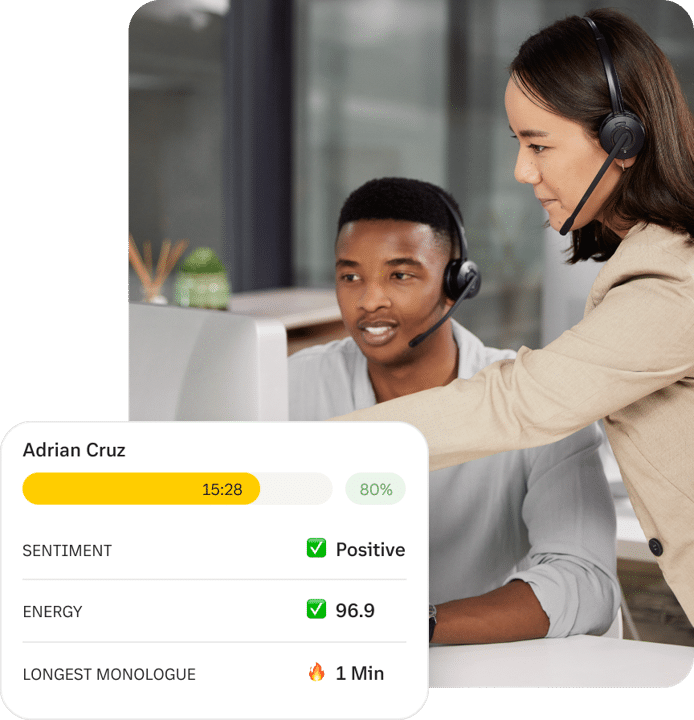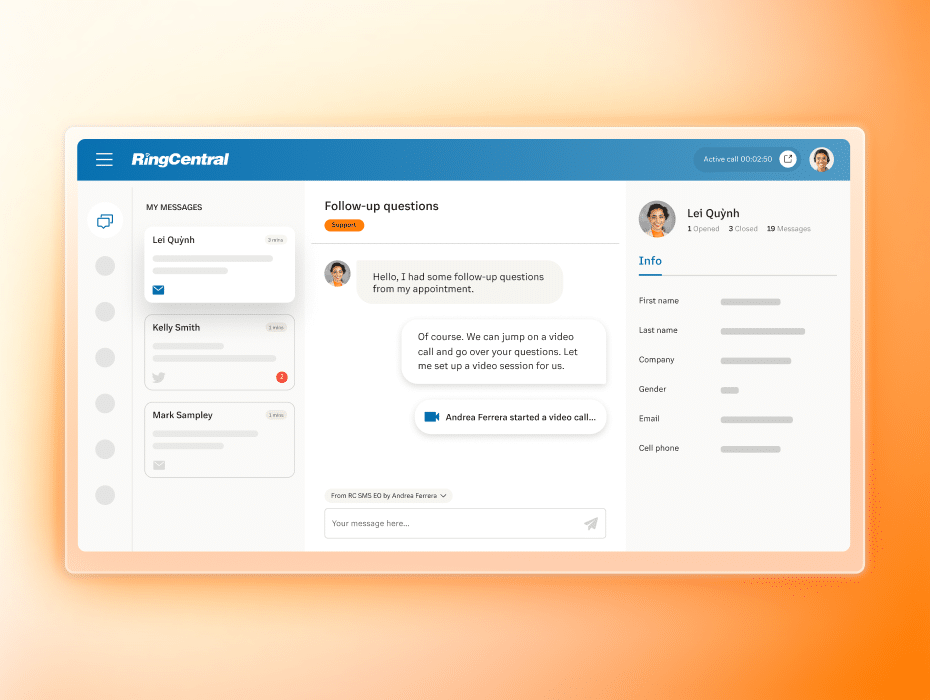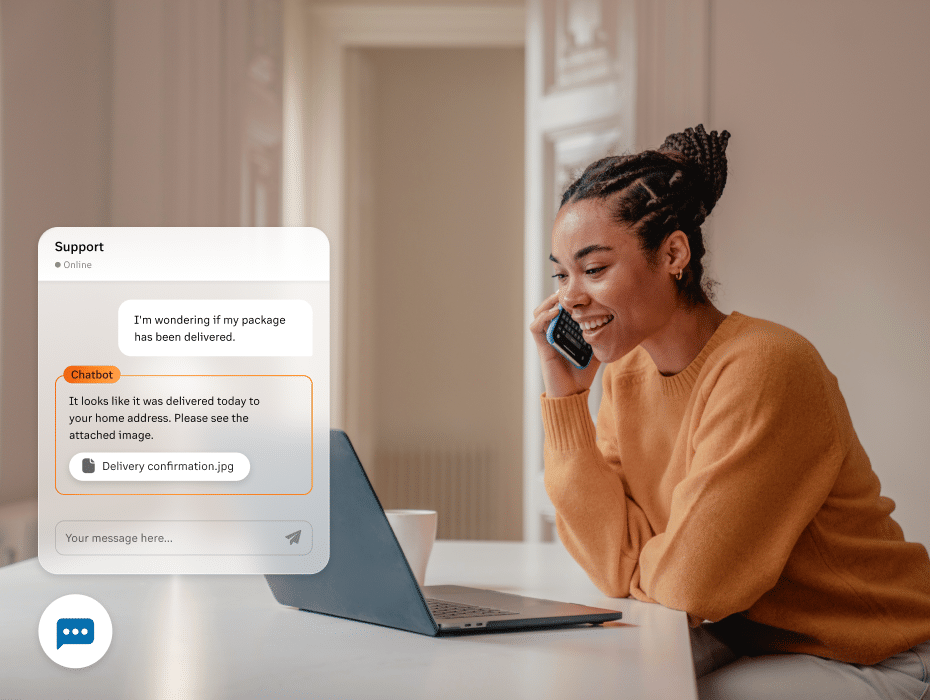Call center speech analytics might sound abstract or intimidating, but it could be the key to unlocking the full potential of your sales and support teams.
Just imagine if you could rapidly analyze every call to your contact center, gaining broad awareness of what’s working (and what isn’t). With the emergence of speech analytics powered by natural language processing (NLP), you can make it happen.
Modern speech analytics software can examine communications between your call center agents and your customers, offering direct insight into what’s delighting or frustrating the people driving your revenue.
With the right tools in place, your contact center managers and agents can gather real-time data for quality assurance without the need to manually evaluate calls—saving time and optimizing key interactions.
This post will delve into more specifics, detail the benefits of call center speech analytics, and offer some implementation tips.
What is speech analytics for call centers?
Speech analytics for call centers deploys AI to analyze conversations in real time. Using word choice, topics, and tone of voice, it produces quality metrics for performance monitoring without any manual reviews. It can also deliver suggestions to help agents resolve issues faster.
Support service providers have always sought ways to achieve greater optimization, so the rise of conversation intelligence—using artificial intelligence (AI) to analyze voice conversations—was inevitable when the technology became good enough. And the technology is only going to keep getting better.
At this point, you might be wondering about all the ways in which AI can improve customer service. So you know what to expect if you do try it, let’s dig deeper to explain some of the specific benefits of call center speech analytics software.
What are the benefits of speech analytics for contact centers?
There are many potential speech analytics benefits to discover, but some are more impactful than others.
Here are the key things you can expect it to do:
- Improve overall service quality
- Get deeper customer experience insights with sentiment analysis
- Identify upsell opportunities
- Reduce non-compliance risk in regulated fields
- Cut back on supervisor micromanaging
- Fix problems in the moment with real-time analytics
1. Improve overall service quality
Speech analytics software can assess all communications in a contact center in real time. That enables contact center supervisors to keep close tabs on agent-customer interactions and monitor agent effectiveness more closely.
Using speech analytics for call center operations can also improve the outcome of initial calls and reduce operational and performance issues that sometimes occur in contact centers.
Paying attention to speech analytics helps agents “get on the same page” as customers, which ultimately increases the resolution rate and reduces overall call volume. In turn, this can alleviate the stresses that overwhelmed agents may face, especially during peak call times. Agents are happier, and customers are more satisfied with their interactions with the contact center.
2. Get deeper customer experience insights with sentiment analysis

A main priority of contact centers is optimizing customer experience through a reduction in repeat calls and average call time. With the implementation of speech analytics, contact center supervisors can access insights into the reasons for repeated contact center calls. Identifying the fundamental cause of various issues is key to improving the operations of a contact center.
With such information on hand, contact center supervisors can pinpoint what’s working and what isn’t, and make improvements and changes accordingly.
3. Identify upsell opportunities
Contact center speech analytics can help agents and supervisors create customized upsell or cross-sell tactics that are designed to target each customer’s needs.
Software can pinpoint the types of responses that specific customer demographics provide, and spur you to make changes or improvements as necessary.
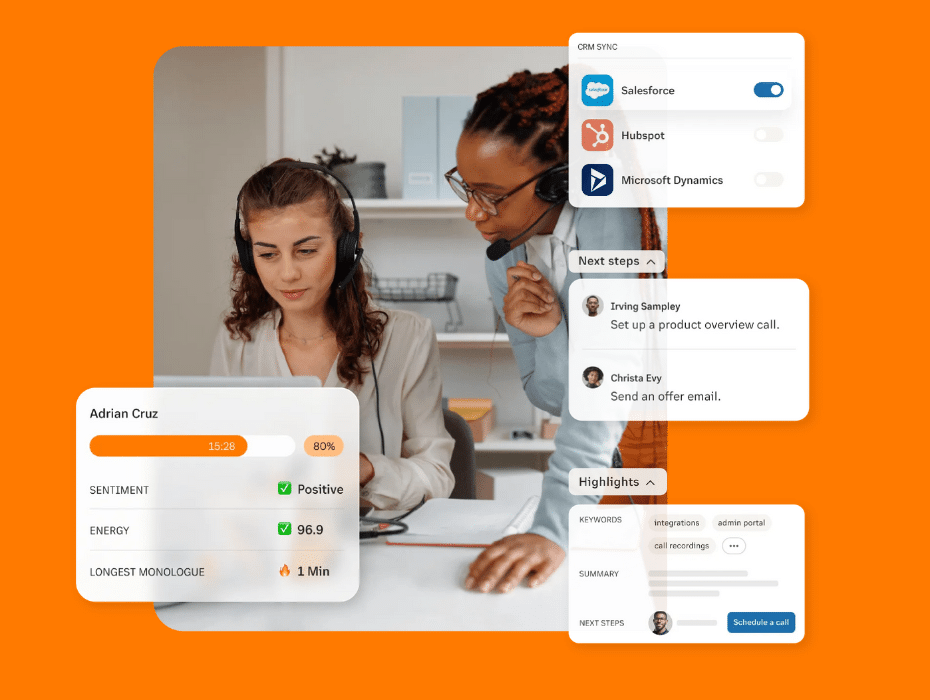
4. Reduce non-compliance risk in regulated fields
There are regulations that are put in place to ensure that agents do not infringe on the privacy of customers, but over the course of an agent’s duties, breaches may occur.
With speech analytics, agents are provided with real-time data to make sure they stay on track and avoid saying or asking anything that would be considered outside the scope of regulatory compliance. The software can track all calls and alert agents when they veer too far off the script.
For instance, real-time speech analytics will alert an agent if a certain keyword or phrase is uttered that may go against compliance rules. In turn, agents can immediately correct themselves. By preventing non-compliance, contact centers can avoid stiff fines that may come with failure to adhere to industry regulations.
Further, unnecessary callbacks can be prevented and certain processes can be automated to reduce the need for overstaffing. Speech analytics provides one more way for contact centers to run a more cost-effective operation that protects their bottom line.
👩💼 💫 Teamwork makes the dream work 💫 👨💼
The key to building a customer-centric team: Enterprise edition eBook
5. Cut back on supervisor micromanaging
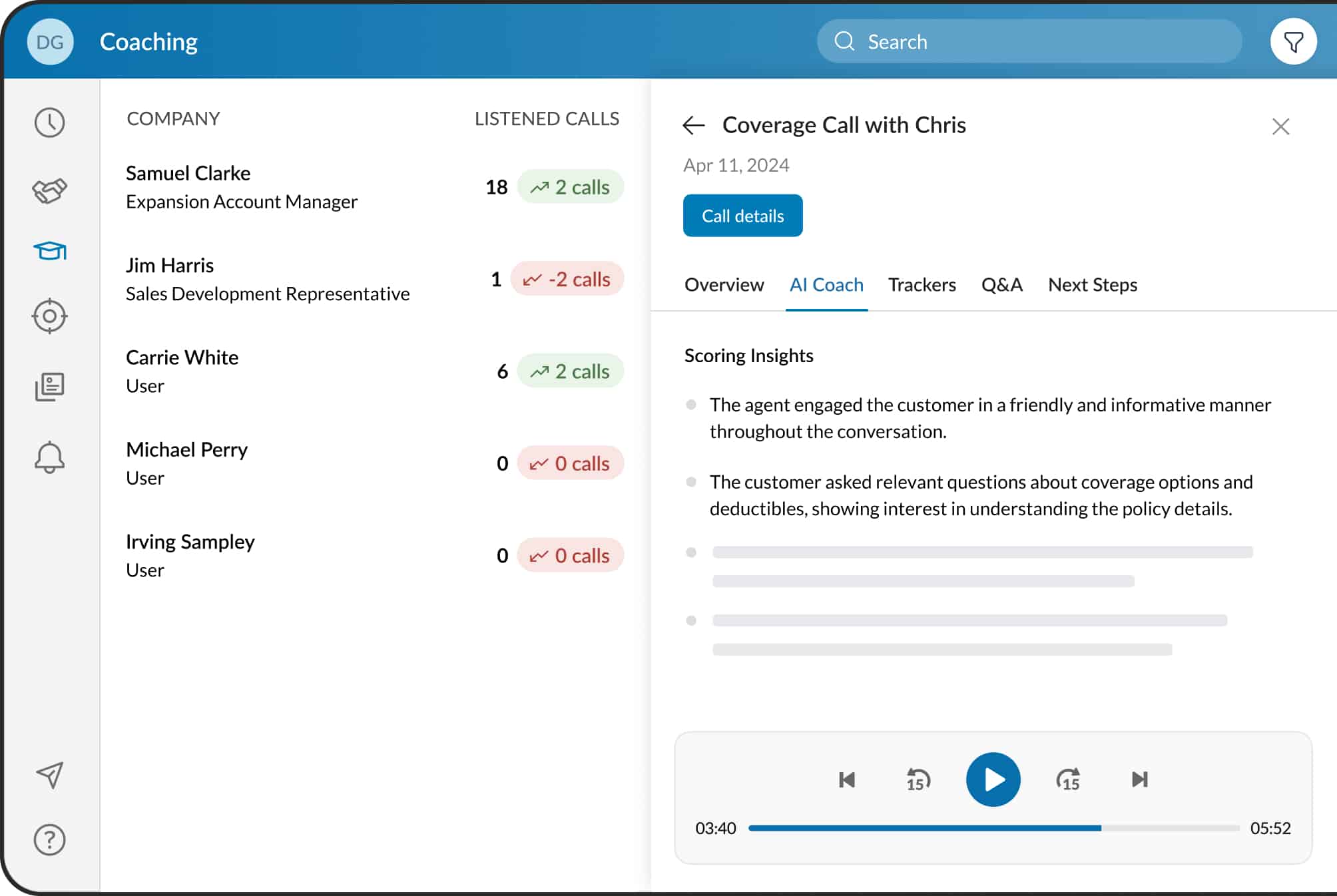
Speech analytics can ensure that supervisors are more productive on the job without having to spend a lot of time manually coaching each call. Instead, they can take a more broad role in assessing how calls are handled.
The automated assessments provided by speech analytics can help supervisors identify where help is needed on the call floor without spending too much time with each individual agent.
6. Fix problems in the moment with real-time analytics

Measuring call quality and customer experience is a crucial metric in every contact center. Though collecting this information and assessing it after-the-fact is certainly helpful, nothing beats real-time data and assessment.
Real-time speech analytics can be used while a call is being handled to give agents guidance needed to make necessary improvements to the interaction on the spot.
For instance, agents may be offered an appropriate response to a query or be prompted for the next actionable step. They may also be reminded to read over current legal disclaimers. These tools may also alert a supervisor that an agent may be in need of assistance.
Rather than allowing errors to take place and fixing them afterward, real-time speech analytics helps rectify any issues immediately. Ultimately, this leads to optimal agent efficiency, improved customer experience, and better business outcomes.
Speech analytics software joins the ever-growing landscape of digital tools available to contact centers to improve customer experience, keep agents engaged in their work, boost company revenues, and keep operational costs low. Streamlining contact center operations is key to competing as an effective and profitable contact center, and digital technology has become a must-have in that endeavor.
RingCentral offers cloud-based software to help contact centers meet these needs. Our solutions are designed to make messaging, video conferencing, and telephone communication easier and more flexible for contact centers.
How to use speech analytics to improve your CX
Curious about how you can use AI to enhance your CX? Through speech analytics, call center software can radically overhaul your operation, and it isn’t as hard as you might think to implement.
Here are the basic steps to follow:
1. Choose the right call center speech analytics software
This might be the most important step in the process. If you partner with a call center speech analytics software provider that doesn’t meet your exact needs (or can’t maintain your required level of quality), you’ll run into issues soon enough.
To find out how our AI-powered contact center platform can improve your customer experience and keep your agents happy, get in touch with a RingCentral customer representative to request your free demo.
2. Onboard your support agents
Investing in call center speech analytics software won’t automatically improve CX. How the software is used is also vital—and it’s your support agents who’ll have it guiding them all the time. The more smoothly you onboard them with the new system, the more effectively they’ll be able to use it.
Because people often resist change, though, you’ll need to get their buy-in first. Walk them through the benefits and cons of speech analytics in general, then explain how the software will make their jobs easier. Show them how real-time suggestions will take some of the pressure off them during tricky calls.
The software you use should have onboarding resources, so use them. RingCentral, for instance, has RingCentral University as a hub of educational materials. Once you get your support agents up to speed on the options available to them, they’ll want to start taking advantage of them.
3. Identify your areas of weakness
Once you’ve had speech analytics gathering data for a while, you can start poring over the metrics and insights to find out where your support systems are falling short. Are your agents taking too long to identify customer grievances? Are there inconsistencies in how they describe your products or services?
No matter how good your support is, you’ll always have room for improvement, and you can be sure that your top competitors aren’t resting on their laurels. Every issue you can find and address—major or minor—will make a difference in the long run.
4. Refine your scripts and processes
Once you’ve collected enough data and discerned the weak spots in your service, you can start making things better.
Pay particular attention to your call scripts because they’ll directly impact most of your calls. If some phrases aren’t being received well, take them out. If certain agent actions are consistently driving negativity, rethink them.
You should also consider your general processes. How could you make things easier for your customers? When are they getting most frustrated, and why? You can’t remove every source of frustration, of course, but you can minimize the resulting dissatisfaction and find small tweaks to earn back some goodwill.
5. Provide targeted training
No matter how well you prepare your scripts and processes, your support agents will ultimately determine how successful your support calls are, so training them well is vital. (Note: If you’ve struggled with the practicalities of training following the rise of remote working, look into virtual training through RingCentral Video.)
Using the data and metrics from speech analytics software, call center training can delve deeper into the unique strengths and weaknesses of specific support agents.
One agent may need to work on a tendency to adopt an aggressive tone while another may benefit from openly acknowledging complaints before responding. If you can highlight their best qualities and work on their worst, you can position your support agents to be maximally productive.
Get in touch with a customer representative from RingCentral today
Frequently asked questions
How does speech analytics work?
Speech analytics fundamentally relies upon natural language processing (NLP), a field of AI (artificial intelligence) that uses algorithms and machine learning in an effort to interpret human language the way humans do.
Having been trained on vast quantities of conversations, NLP systems can do many things with calls: Identify what’s being discussed, estimate how the participants feel, produce transcriptions with fillers removed, suggest responses, and even generate high-quality translations.
What is speech analytics software?
In the context of contact centers, speech analytics software packages the features mentioned above to make them accessible to managers and support agents. In addition to real-time monitoring and sentiment analysis, it can offer compliance ratings and suggestions, aid lead generation, and assess agent performance.
How can I use speech analytics software?
Following the steps we covered earlier will get you moving in the right direction, but a further tip is to listen closely to agent feedback. In a call center, speech analytics benefits everyone, but it’s the support agents who feel the difference most keenly. If your agents are struggling to understand functions, take the time to coach them.
You may also find that your agents come up with ideas for doing more with your speech analytics system or for switching up your processes. Having a clear pipeline for ideation will help your agents feel valued and get everyone working together to extract maximum value from the speech analytics platform.
Originally published Jun 04, 2024, updated Jun 25, 2024
